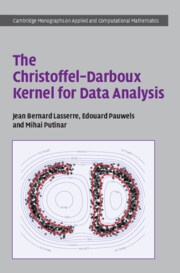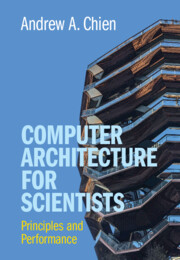Refine search
Actions for selected content:
2540 results in Computational Science
Frontmatter
-
- Book:
- The Christoffel–Darboux Kernel for Data Analysis
- Published online:
- 31 March 2022
- Print publication:
- 07 April 2022, pp i-vi
-
- Chapter
- Export citation
3 - Univariate Christoffel–Darboux Analysis
- from Part One - Historical and Theoretical Background
-
- Book:
- The Christoffel–Darboux Kernel for Data Analysis
- Published online:
- 31 March 2022
- Print publication:
- 07 April 2022, pp 27-41
-
- Chapter
- Export citation
9 - Transforms of Christoffel–Darboux Kernels
- from Part Three - Complementary Topics
-
- Book:
- The Christoffel–Darboux Kernel for Data Analysis
- Published online:
- 31 March 2022
- Print publication:
- 07 April 2022, pp 125-135
-
- Chapter
- Export citation
4 - Multivariate Christoffel–Darboux Analysis
- from Part One - Historical and Theoretical Background
-
- Book:
- The Christoffel–Darboux Kernel for Data Analysis
- Published online:
- 31 March 2022
- Print publication:
- 07 April 2022, pp 42-60
-
- Chapter
- Export citation
Part One - Historical and Theoretical Background
-
- Book:
- The Christoffel–Darboux Kernel for Data Analysis
- Published online:
- 31 March 2022
- Print publication:
- 07 April 2022, pp 7-8
-
- Chapter
- Export citation
Index
-
- Book:
- The Christoffel–Darboux Kernel for Data Analysis
- Published online:
- 31 March 2022
- Print publication:
- 07 April 2022, pp 167-168
-
- Chapter
- Export citation
7 - Applications and Occurrences in Data Analysis
- from Part Two - Statistics and Applications to Data Analysis
-
- Book:
- The Christoffel–Darboux Kernel for Data Analysis
- Published online:
- 31 March 2022
- Print publication:
- 07 April 2022, pp 87-112
-
- Chapter
- Export citation
Part Three - Complementary Topics
-
- Book:
- The Christoffel–Darboux Kernel for Data Analysis
- Published online:
- 31 March 2022
- Print publication:
- 07 April 2022, pp 113-114
-
- Chapter
- Export citation
Symbols
-
- Book:
- The Christoffel–Darboux Kernel for Data Analysis
- Published online:
- 31 March 2022
- Print publication:
- 07 April 2022, pp xi-xii
-
- Chapter
- Export citation
8 - Further Applications
- from Part Three - Complementary Topics
-
- Book:
- The Christoffel–Darboux Kernel for Data Analysis
- Published online:
- 31 March 2022
- Print publication:
- 07 April 2022, pp 115-124
-
- Chapter
- Export citation
10 - Spectral Characterization and Extensions of the Christoffel Function
- from Part Three - Complementary Topics
-
- Book:
- The Christoffel–Darboux Kernel for Data Analysis
- Published online:
- 31 March 2022
- Print publication:
- 07 April 2022, pp 136-154
-
- Chapter
- Export citation
Preface
-
- Book:
- The Christoffel–Darboux Kernel for Data Analysis
- Published online:
- 31 March 2022
- Print publication:
- 07 April 2022, pp xiii-xvi
-
- Chapter
- Export citation
Part Two - Statistics and Applications to Data Analysis
-
- Book:
- The Christoffel–Darboux Kernel for Data Analysis
- Published online:
- 31 March 2022
- Print publication:
- 07 April 2022, pp 75-76
-
- Chapter
- Export citation
Foreword
-
- Book:
- The Christoffel–Darboux Kernel for Data Analysis
- Published online:
- 31 March 2022
- Print publication:
- 07 April 2022, pp ix-x
-
- Chapter
- Export citation
1 - Introduction
-
- Book:
- The Christoffel–Darboux Kernel for Data Analysis
- Published online:
- 31 March 2022
- Print publication:
- 07 April 2022, pp 1-6
-
- Chapter
- Export citation
5 - Singular Supports
- from Part One - Historical and Theoretical Background
-
- Book:
- The Christoffel–Darboux Kernel for Data Analysis
- Published online:
- 31 March 2022
- Print publication:
- 07 April 2022, pp 61-74
-
- Chapter
- Export citation
2 - Positive-definite Kernels and Moment Problems
- from Part One - Historical and Theoretical Background
-
- Book:
- The Christoffel–Darboux Kernel for Data Analysis
- Published online:
- 31 March 2022
- Print publication:
- 07 April 2022, pp 9-26
-
- Chapter
- Export citation

The Christoffel–Darboux Kernel for Data Analysis
-
- Published online:
- 31 March 2022
- Print publication:
- 07 April 2022

Computer Architecture for Scientists
- Principles and Performance
-
- Published online:
- 25 March 2022
- Print publication:
- 10 March 2022
-
- Textbook
- Export citation
Frontmatter
-
- Book:
- Computer Architecture for Scientists
- Published online:
- 25 March 2022
- Print publication:
- 10 March 2022, pp i-iv
-
- Chapter
- Export citation
